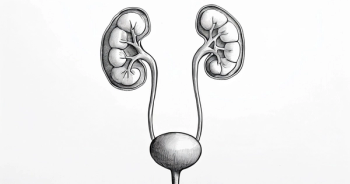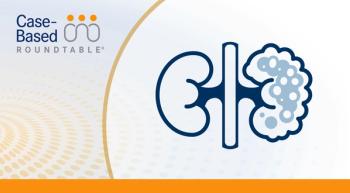
Peers & Perspectives in Oncology
- June II 2025
- Pages: 3
George Shares Takeaways From IO Trials and AE Management in Pretreated RCC
During a live event, Saby George, MD, and participants discussed tolerability concerns in patients with recurrent renal cell carcinoma who received prior immune checkpoint inhibitor.
EVENT REGION Northeast
PARTICIPANT LIST Qamar Zaman, MD | Yu-Ning Wong, MD | Naomi B. Haas, MD | Christopher Del Prete, MD | Alina Basnet, MD | Kayvan Zarrabi, MD | Nirmala Nathan, MD | Risa Wong, MD
CASE SUMMARY
- The patient is a man aged 61 years, is married, has 2 grown children and 5 grandchildren who live nearby, and leads an active lifestyle (daily walks, golfs regularly).
- History of low-volume, indolent metastatic clear cell renal cell carcinoma (ccRCC), status post left nephrectomy and adrenalectomy
- Based on low-volume, indolent disease and patient preference: observation only
One and a half years post nephrectomy CT scan:
- New paratracheal lymph node (2.0 × 1.5 cm) and more than 10 pulmonary nodules on CT
- Lung biopsy confirmed metastatic ccRCC
- Laboratory results: within normal limits
- ECOG performance status: 1
- The patient received first-line cabozantinib (Cabometyx) plus nivolumab (Opdivo).
Follow-up:
- Decrease or stabilization in metastatic lesions noted on follow-up imaging.
- He tolerated therapy well, with 1 interruption due to hypothyroidism on routine labs (treated with levothyroxine).
- Fourteen months after initiation of systemic therapy, the patient reported increasing back pain, mild nausea, weight loss, and new onset of persistent rib pain.
- Imaging confirms progressive disease: growth of paratracheal lymph node (was 20 × 15 mm; now 25 × 28 mm), new mediastinal and hilar nodal involvement, new retroperitoneal nodes, and new lytic osseous lesions
- ECOG performance status: 2
DISCUSSION QUESTIONS
- What is your reaction to the data from the phase 3 TiNivo-2 study (NCT04987203)?
- Do you consider any of the results to be clinically meaningful, practice changing, or practice confirming?
Zaman: Why was the dose of tivozanib [Fotivda] lower in the immune checkpoint inhibitor [ICI] group compared with the standard dose [0.89 mg vs 1.34 mg, respectively]?
George: The sponsor had discussed [it] with the FDA, and because of concerns of combination toxicities with nivolumab, it was decided to use a lower dose.
Y. Wong: Do you know what increased toxicity there was from putting the two together?
George: I think hypertension was one of the concerns. But that’s the same dose used in the standard comparator arm.
Haas: That is what I had heard as well. It was [that] the FDA seemed to think that there were concerns about hypertension from the nivolumab, which doesn’t make a lot of sense, but it is what it is.
George: Does anybody want to comment on the performance of [single-agent] tivozanib on this trial?
Zaman: It looks like we should use the standard dose. I have used tivozanib. It’s a much better-tolerated tyrosine kinase inhibitor [TKI] as compared with cabozantinib or lenvatinib [Lenvima], so that tells us that if we need to start, we need to start at the standard dose, because of the difference.
George: That’s right, and you can also dose reduce in patients who don’t tolerate, as with any other TKIs. Was anybody surprised by the result of a single agent vs a combination?
Del Prete: Weren’t these predominantly patients who had progression on IO [immunotherapy]?
George: I think 71% of patients had a prior ICI.1
Del Prete: So, I don’t know what the rationale would be for why nivolumab would be helpful here. Are most of us rechallenging with IO within 6 months of progression? A fairer comparison would be lower-dose tivozanib vs higher-dose tivozanib.
George: That’s a great point. One more thing is, patients who had gone on the trial who had prior immune checkpoint combinations had IO/IO as well as IO/TKI. The patients who have progression from IO/IO may be slightly different from patients who have progression on IO/TKI.
Del Prete: But 9.2 months is a good [median] progression-free survival [PFS] to achieve. I’m just questioning the comparison a bit. Tivozanib is a great option.
George: Do you think this is clinically meaningful or practice confirming? It’s not practice changing because the combination failed to show efficacy.
Basnet: I think it’s clinically meaningful…to see the 9.2 months’ PFS benefit in the third-line setting, especially after IO and much stronger TKIs. It’s in favor of tivozanib and practice confirming, because with these data and the [phase 3] CONTACT-03 study [NCT04338269], it’s showing that IO beyond IO is not going to help. I think tivozanib/nivolumab was compared against tivozanib because this was conceptualized when CONTACT-03 was still ongoing. I think the concept of IO beyond IO is done. That is practice confirming, because in the community, [some] people still tend to believe that there may be a use for IO after IO progression. Now we have seen 2 phase 3 trials that show IO is not going to help our patient and may add toxicity.1,2
I have a similar sentiment on the lower dose of tivozanib. I also think, how do we define these doses? Even in [the phase 3 trial] CheckMate 9ER [NCT03141177], the cabozantinib was [given] at 40 mg vs 60 mg [as a single agent]. How do we choose that, and is that affecting our patient? This is a cross-trial comparison, so it’s hard to justify in that sense. [Still], this is very meaningful for our patient with a manageable toxicity profile and confirming that IO beyond IO is not to be used.
George: From the TiNivo-2 trial, any-cause treatment-emergent adverse events [TEAEs], grade 3 or higher adverse events, serious adverse events, TEAEs leading to discontinuation, TEAEs leading to dose interruption, etc, were well balanced between the 2 arms [Table 13]. Tivozanib as a single agent performed pretty well here, and the median duration of treatment was longer with the single-agent tivozanib compared with the tivozanib/nivolumab combination.
The most common TEAEs [were] hypertension, fatigue, diarrhea, nausea, and decreased appetite…and they were fairly comparable between the 2 arms. No new safety concerns emerged from that trial.
DISCUSSION QUESTION
- Do you agree that the results of the TiNivo-2 and CONTACT-03 studies demonstrate that ICI rechallenge is not efficacious?
George: CONTACT-03 was a large trial that compared atezolizumab [Tecentriq] plus cabozantinib after prior immune checkpoint inhibitor compared with cabozantinib. This was a phase 3 trial that randomly assigned patients who had prior immune checkpoint inhibitor and TKI. Atezolizumab at 1200 mg IV [intravenously] every 3 weeks plus cabozantinib 60 mg daily orally was compared with cabozantinib 60 mg daily orally. The co–primary end points were independent, centrally assessed PFS and overall survival. The median PFS is not much different, 10.6 vs 10.8 months between the [respective] arms and the median overall survival was 25 months vs not reached for the single-agent cabozantinib. The objective response rate was 41% vs 41% with only partial responses and no complete responses. The rate of progressive disease as best response was 4% vs 5%, so that’s consistent with significant disease control rate in both arms.2
In CONTACT-03, 100% of the patients had prior ICI, and in TiNivo-2, 71% had prior ICI. That is the relevance of these data. Even though those 2 trials were negative, they created some practice-confirming data that these are robust choices in the second line after immune checkpoint inhibitor [Table 21,2]. The progression-free survival was 10.8 months for cabozantinib and 7.4 months for tivozanib from the TiNivo-2 trial. In patients who had ICI as immediate prior treatment, it’s 10.8 months vs 9.2 months, very similar numbers. AEs and grade 3/4 AEs were also very similar.
DISCUSSION QUESTIONS
- What VEGF TKI–related toxicities are most concerning to you?
- Which do you find most challenging to manage?
George: What VEGF TKI–related toxicities are most concerning to you? A lot of you get called when you prescribe VEGF TKIs, especially the most important ones, like lenvatinib and cabozantinib. What are the common toxicities that get you on the phone?
ZARRABI: Many of the listed toxicities are manageable overall: the hypertension, diarrhea, and hand-foot syndrome. The loss of appetite, fatigue, and treatment-related decline are most concerning to me, whereas other things can be mitigated with drug holds or other medications.
GEORGE: For hypertension, Dr Zarrabi, how would you approach it? Would you reduce the dose, or just add an antihypertensive and wait before you reduce the dose?
Zarrabi: I typically add 1 antihypertensive, if needed max it out, or sometimes add a second before considering dose reduction.
George: Right, and if it’s a grade [3 or 4] hypertension, you want to hold off and give a break and have control before you start back up.
Nathan: The main toxicity I’m concerned with is diarrhea. It’s a quality-of-life issue, and I want to make sure they’re not dehydrated. They go through multiple therapies, start a lower potency drug like loperamide [Imodium] all the way up to diphenoxylate/atropine [Lomotil], and I’ve even used octreotide acetate [Sandostatin] on some of these patients.
George: I see, and do you also have any suggestion regarding diet or probiotics?
Nathan: I tell them to take probiotics and high fiber and a low-dairy diet, but often patients have a mind of their own and don’t stick to the diet.
George: Those are great points, and that’s pretty standard management for diarrhea related to TKI.
DISCUSSION QUESTIONS
- What are your reactions to the final analysis data from LITESPARK-005 (NCT04195750)?
- What do you think about the toxicity profile of belzutifan (Welireg)?
George: What do you think about the toxicity profile of belzutifan? How do you manage anemia?
R. Wong: I think it’s pretty well tolerated. In addition to patients with metastatic RCC, I have some people with von Hippel-Lindau disease [VHL] who are on it, and almost all of them have developed some degree of anemia and hypoxemia, but for the anemia, if the hemoglobin gets to below 8 g/dL, then you just have to hold the drug until it comes back up. For the hypoxemia, it’s interesting because patients don’t actually feel short of breath, but if you check their [pulse oximetry], it’s often low. I’ve had some patients for whom I had to hold it because their oxygen saturation was below 88%, and then just resume the drug when it comes back up. But I haven’t had to stop therapy for good on any of my patients.
George: For anemia, have you used erythropoietin?
R. Wong: I have not used erythropoietin. I hold the drug for a period of time, and then usually the hemoglobin comes back up within a couple of weeks.
Basnet: In my practice, I have had a different experience with belzutifan when I have used it in the VHL syndrome vs the RCC setting. When I’ve used it in patients with the germline VHL mutations [leading to] hemangioblastomas in the brain, RCC, or the pancreatic neuroendocrine tumors, they have had better tolerance vs the patients who have metastatic RCC post progression on different lines. That is because these people [have poor performance status after] the other therapies in the past. I have not used erythropoietin for anemia in the germline VHL group, but in the metastatic RCC group, I have used erythropoietin to maintain them between 9 and 10 g/dL.
Do you think the LITESPARK-005 comparator arm is a fair competitor arm, comparing everolimus against belzutifan? Should there have been a combination with TKI? Was it like that because the trial allowed the prior use of lenvatinib? The dose of everolimus that was done in this trial, 10 mg, might also influence the response rate that we saw with everolimus alone.
Talking about the AE profile, I had to hold belzutifan in a patient with germline VHL for fatigue more than anything else. They were not significantly anemic or hypoxic, but they were just fatigued. For patients who were avid skiers, I would hold their belzutifan for 3 to 4 months during the ski season and restart them.
George: This was a third- and fourth-line trial [allowing] patients who had up to 3 lines of treatment, so there were no good data to set a comparator.4 This was a historical comparator, which was beaten by a lot of other drugs like nivolumab and cabozantinib, so that’s probably why the FDA allowed for that as a comparator, because we’re talking about fourth line.
Y. Wong: Do you have experience in treating patients on 3 liters of home oxygen? What sort of precautions do you take, or how do you manage somebody like that?
George: That’s a very tricky situation because they’re at high risk for worsening hypoxia, and then they may become very unstable if hypoxia makes them more symptomatic. If they are dependent on 3 liters, they cannot have oxygen delivery of more than 3 or 4 liters at home, so it’s going to be very tough. I would be very cautious in using this drug in that situation.
Haas: I have been a little nervous offering belzutifan to anybody with severe chronic obstructive pulmonary disease or hypoxia issues. The only situation I could think of would be if this were a situation where the patient had been on [belzutifan] for a very long time, and you were sure of how they were tolerating belzutifan, and they had to have oxygen for a different reason. I still would be very nervous about that situation.
DISCLOSURES: George previously reported consulting or advisory roles from AVEO, AstraZeneca, Bayer, Bristol-Myers Squibb, Corvus Pharmaceuticals, Eisai, EMD Serono, Exelixis, Merck, Pfizer, QED Therapeutics, Sanofi/Genzyme, and Seattle Genetics/Astellas. His institution has received research funding from Agensys, Aravive, AVEO, Bayer, Bristol Myers Squibb, Calithera Biosciences, Corvus Pharmaceuticals, Eisai, Gilead Sciences, Merck, Novartis, Pfizer, Seattle Genetics/Astellas, and Surface Oncology. Haas previously reported consulting or advisory roles with AVEO, Calithera Biosciences, Eisai, Exelixis, Merck Sharp & Dohme, Pfizer, and Roche/Genentech; and expert testimony with Eli Lilly.








































